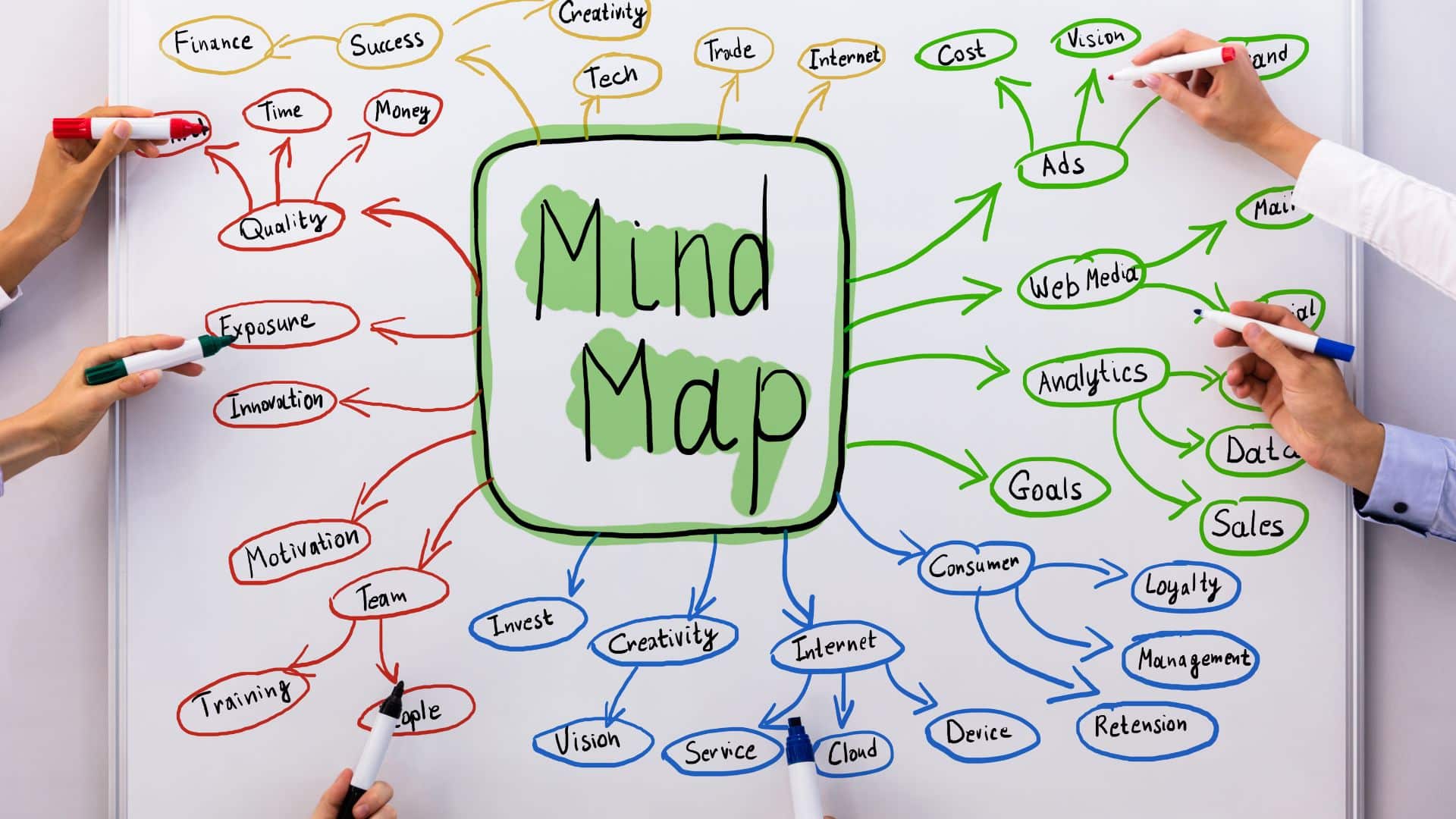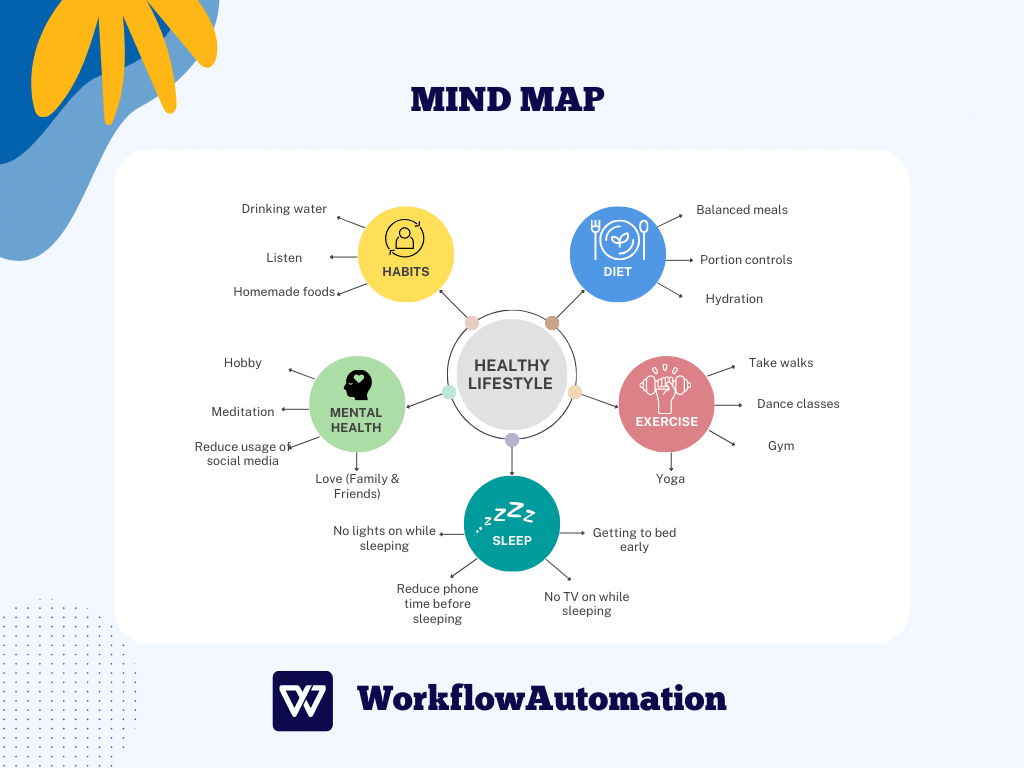In today’s dynamic environment, striving for personal and professional excellence requires adopting innovative methods based on visual frameworks, streamlining business processes, and accelerating productivity. Among the mentioned methods lies the potential of mind map ideas, a true game-changer.
Mind maps enable you to make decisions more efficiently, enhance organization, facilitate better memory retention, and nurture creativity. By harnessing the potential of mind maps, you can approach every project with a structured mindset and successfully execute it.
In this article, we will delve into the essence of mind maps, exploring their nature and purpose while uncovering the step-by-step process of creating one. Let’s start!
What is a Mind Map?
A mind map is a visual diagram invented by Tony Buzan in 1974. The goal of mind maps is to visually connect ideas and concepts by branching them into multiple interconnected elements to simplify complex concepts. Each branch represents a specific idea or aspect related to the central concept.
Mind maps provide a clear and structured overview of information using symbols, words, and colors to assign significance and relevance to each element.
They serve as versatile tools, offering various benefits in different contexts, and are invaluable for enhancing long-term memorization, as their visual and organized nature aids in recalling vast amounts of information more easily.
Additionally, mind maps simplify the complexities of topics, making them useful for problem-solving and decision-making processes.
Their broad applications extend across industries, where professionals and educators find mind maps valuable. In education, students can study more productively and comprehend lessons more easily using mind maps. Meanwhile, educators utilize them to create engaging training materials and simplify explanations for their students.
When Should You Use a Mind Map?
Mind maps offer a versatile and invaluable approach to organizing and executing various activities through visual representation. Here are three examples of when mind maps can be utilized and highly beneficial:
#1. For Meetings
Mind maps prove highly effective during meetings, providing a visually engaging and structured platform for brainstorming and generating ideas.
Collaborators can contribute ideas by having the central concept branch out with various subtopics, ensuring all ideas are captured and visually connected.
Active participation is encouraged, fostering dynamic discussions. Meeting attendees can identify essential action items, prioritize tasks, and establish clear project management goals, ensuring organized and actionable outcomes.
#2. For Project Planning
Mind maps are valuable instruments in complex project planning, where they aid in organizing and simplifying the entire project’s structure from the initial phase to the desired outcome.
By visually representing the project’s milestones, scope, and individual responsibilities, mind maps facilitate team members’ understanding of their roles, team connections, and overall project flow.
This transparent display fosters clear communication, streamlines workflows, and improves team coordination, making project execution more efficient.
#3. For Business Planning
These maps are excellent tools for strategic business planning as well. Business plans gain comprehensive and well-structured frameworks by creating a central node for the company’s vision and branching into different areas like marketing and finance.
The process of mind-mapping ideas helps businesses identify potential opportunities and explore new directions. Moreover, they enable businesses to adapt to changing demands and make successful adjustments, promoting continuous growth and development.
How to Create a Mind Map
Here is a step-by-step guide on how to create a mind map:
- Choose a central topic: Select a central topic or idea that will be the focus of your mind map. Write it in the middle of the page or screen, making it visually prominent.
- Add main branches: Identify the main categories or subtopics related to the central topic. Draw branches from the central idea and label each with a concise title representing a main category.
- Generate sub-branches: For each main branch, brainstorm sub-topics or ideas related to the category. Extend new branches from the main one, creating a hierarchical structure. Use keywords or brief phrases to label the sub-branches.
- Use visual elements: Enhance your mind map with visual elements, such as icons, symbols, or colors. These elements add visual appeal and aid in information retention. For example, you can use icons to represent different types of ideas or color-coding to categorize branches.
- Embrace creativity: There are many online mind map examples and mind map designs, but make sure not to limit yourself to traditional formats. Mind maps are flexible and can take various shapes and styles. Feel free to use images, doodles, or sketches to represent ideas, making the mind map more personalized and engaging.
- Make connections: Identify relationships and connections between different branches and elements in the mind map. Use arrows or lines to show how ideas are related or linked, promoting a deeper understanding of the concept.
- Review and refine: Take a moment to review your mind map and ensure it effectively represents your ideas. Edit and refine as needed to enhance clarity and coherence.
Mind Map Example
Let’s take a look at an example of a mind map and its main elements before you see the visual representation of the same.
Central Theme: Healthy Lifestyle
Associations:
- Diet
- Exercise
- Sleep
- Mental Health
- Habits
Curved Lines: Connect each association to the central theme.
Keywords: Under each association, we can add specific keywords or subtopics.
- Diet: Balanced meals, portion controls, hydration.
- Exercise: Cardio, strength training, flexibility.
- Sleep: 7-8 hours, consistent schedule, relaxation.
- Mental Health: Stress management, mindfulness, social connection.
- Habits: Quit smoking, limit alcohol, regular health checkups.
Proximity: Keep related keywords close to their parent association for clear organization.
Seven Associations: By limiting the number of primary associations to seven, we maintain a manageable and clear mind map.
Here’s a visual example of how a mind map should look like:
5 Benefits of Using Mind Maps
Let’s explore the five main benefits of utilizing mind maps:
#1. They Reduce Complexity
Mind maps make it easier to deal with complicated ideas. They help you understand the relationships between different things by breaking down complex knowledge into small pieces that are linked together.
This simplification makes it easier to understand and solve problems and make decisions. Additionally, it fosters a more creative and organized approach to tackling complex challenges.
#2. They Organize Ideas
These visual tools are great for organizing ideas, whether planning a project, outlining an essay, or preparing for a presentation. They let you put your ideas in a hierarchy, with the main idea in the middle and the secondary ones coming from it.
This structure ensures that nothing is missed and the thoughts flow well together. It also gives a clear and logical framework for your creative pursuits, encouraging good collaboration and idea growth.
#3. They Help You Visualize the Topic
Mind maps are great for turning monotonous, text-heavy topics into colorful, visually appealing ones. They use images, connecting lines, and colorful nodes to make you think about both the analytical and creative aspects.
This dynamic method not only makes it more fun to understand difficult topics but also makes it much easier to learn and remember things for long periods of time.
#4. Stimulate Creativity
Mind maps promote creativity because they don’t require you to think in a straight line. Your brain is always coming up with new ideas and thoughts as it explores different pathways and makes connections that you wouldn’t expect.
People are more likely to come up with creative solutions to a wide range of problems when they are free to connect ideas that don’t seem to go together. This makes mind maps a powerful tool for stimulating creativity and original problem-solving.
#5. Enhance Learning and Studying
Students and others who want to keep learning should embrace mind maps. These visual tools prove invaluable when studying, as they allow you to condense knowledge, making it easier to understand the lessons and memorize them for tests.
Furthermore, mind maps are not only practical but also enjoyable to look at, making the process of learning complex subjects more fun and satisfying.
5 Tips on How to Use Mind Maps Effectively
Now that you’re properly acquainted with the concept of mind maps, let’s see how you can easily and effectively use them through the following five tips:
- Use simple words: Use short and clear words in your mind maps to keep everything simple. Avoid long lines that make the map look cluttered and hard to understand. Simple wording makes it easier to understand and keeps things clear and organized.
- Use symbols and pictures: Add important symbols and pictures to your mind maps. Visual features add another layer of meaning and help people remember what they have learned. They also add imagination to your maps, making looking over them more fun.
- Color your thoughts: Use different colors to group and draw attention to other parts of your mind map. Color coding makes things easier to see and makes it easier to connect ideas. This method makes your mind map a colorful, eye-catching tool that gets your brain thinking.
- Review and revise: Look at your mind maps often to help you remember the knowledge. As you review, make changes and add to your mind maps as needed. This ensures that your maps are always correct and up to date so they can be used as valuable references in the future.
- Connect and branch: Let your thoughts flow freely and make connections between different nodes. The power of mind maps comes from the fact that they are not organized in a straight line, which allows you to discover connections and relationships with ease.
Challenges of Using Mind Maps
Despite the simplicity and many advantages of using mind maps, there are a few drawbacks as well. You may face the following challenges when using one:
- Overcrowding: One common challenge when it comes to mind maps is overcrowding, especially when dealing with complex topics. Attempting to fit too much information into a limited space can be confusing and defeat its purpose of simplifying ideas.
- Adaptability for some subjects: While mind maps are versatile, they may only be suitable for some subjects or types of information. Some topics, particularly those that require linear, sequential explanations, may not fit naturally into a non-linear format of mind maps. In such cases, alternative methods might be more effective for organizing and presenting the information.
Conclusion
Mind maps, meaning a visual representation of interconnected ideas, offer a valuable approach to information organization and problem-solving. They are powerful tools for acquiring knowledge, breaking down complex projects into manageable parts, and promoting brainstorming sessions.
With their flexible and creative nature, mind maps are particularly well-suited for capturing ideas, fostering innovation, and tackling challenges with a more free-flowing approach.
When faced with the concept of mind maps in the future, armed with the knowledge of their applications, you can confidently choose this method for dynamic exploration and effective collaboration.







